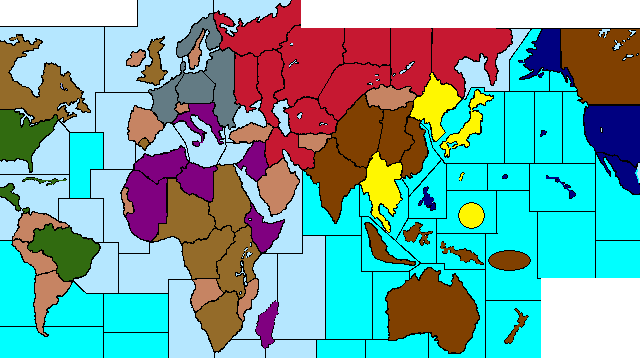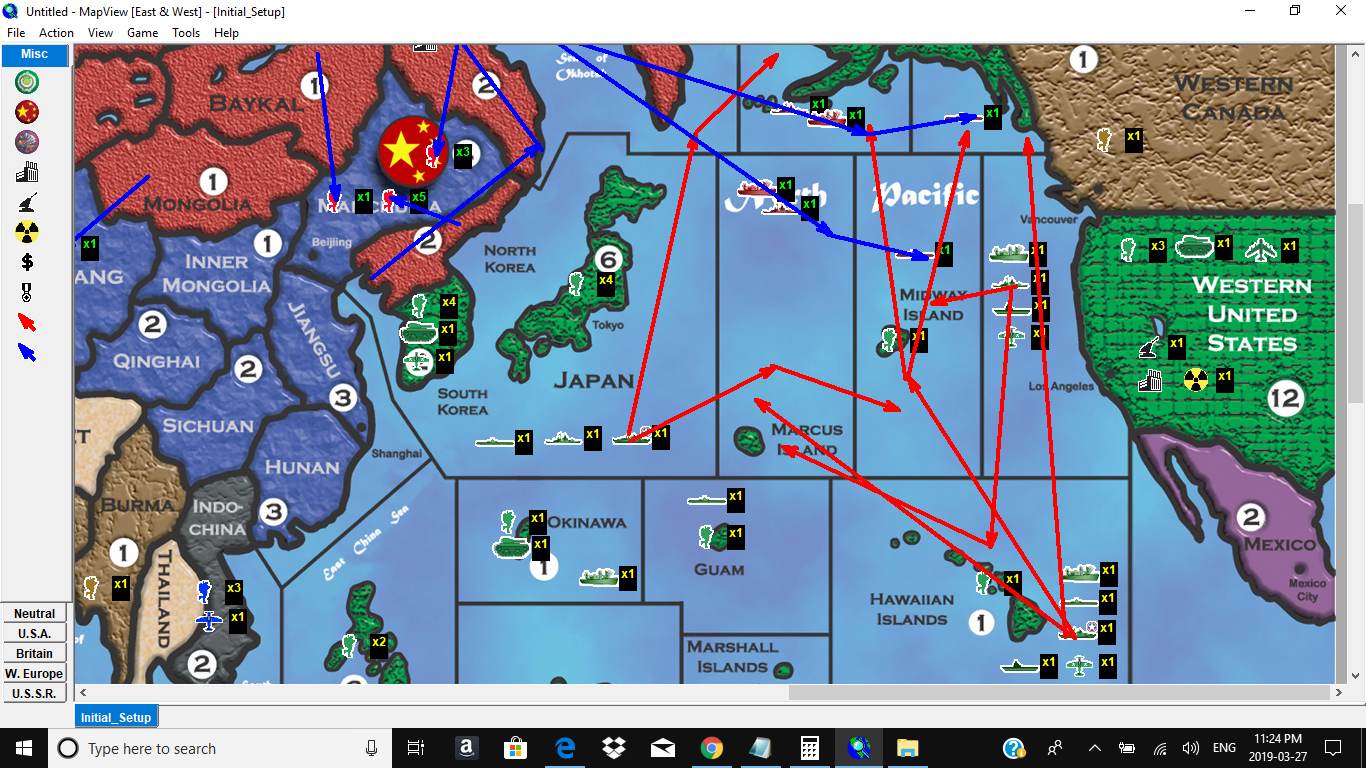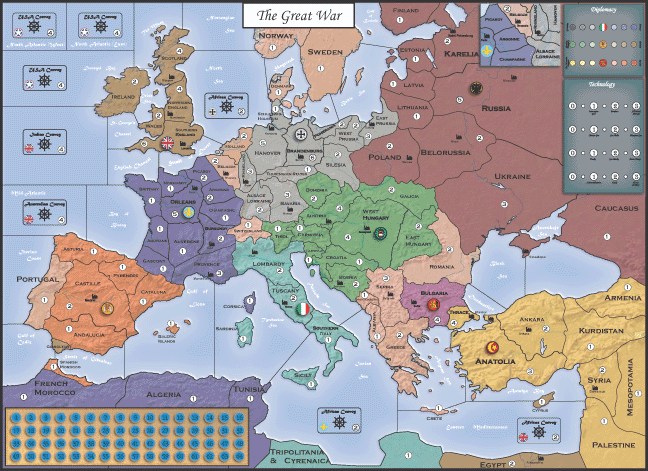Turn Order:
(With the intention of keeping as close to the original turn order, while still slotting in the added countries)
- USSR
- a) Italy (and Vichy France)
b) Germany
- a) UK (Atlantic)
b) China (includes India, Dutch, ANZAC, etc.)
- Japan
- a) US Pacific
b) US Atlantic
Round Zero / “Impulse”:
Prior to the first full round, the Axis get one round to act. This should be played out in the turn order described above, omitting the Allied turns.
The Axis conduct all phases of their turns during this round, with some very important bonuses added:
- Infantry & Armor: attack power is increased by 2, costs are reduced by 1 IPC
- Fighters & Bombers: attack with 2 dice instead of 1, costs are reduced by 2 IPC
- Naval units: attack power is increased by 1, costs are reduced by half
During this round, Allied units defend as per normal, with one notable exception: since they are not yet at war, AA guns belonging to the USSR and USA do not fire.
Axis Advantage / “Russia Restricted”
On the first round, the USSR and the US (both Atlantic and Pacific) may only conduct the following phases of their turns: Purchase Units, Place Units, Collect Income.
In addition to the bonuses on Round Zero, all three Axis countries gain these benefits:
- all Axis battleships are 2-hit battleships
- all Axis powers have Super Submarine technology
- all Axis powers have Jet Power technology
Setup & Territorial Changes:
The original setup for Classic is used, however changes in ownership of a territory also govern changes in the nationality of ALL units listed for that territory (including naval units) with the following exceptions:
- All German naval units are given to Italy (including any newly purchased units)
- All Soviet naval units are given to the UK; the USSR may not produce naval units in this scenario

As you can see from the map above, the sea zones are broken down into two sections:
- those bordering the territories of USSR, Germany, Italy, UK, and US Atlantic – to be used only by the navies and air forces of those countries
- all other sea zones – to be used by the navies and air forces of China, Japan, and US Pacific
You’ll note that this limitation creates one sea zone in the mid-Atlantic which is effectively impassable; feel free to adjudicate this differently, if you find a change to be helpful.
Industrial Complexes / “Victory Cities”:
Add an AA gun and Industrial Complex to the following territories:
- Ukraine SSR
- South Africa
- India
- Australia
No new industrial complexes may be built.
In this scenario, the number of units a complex can produce is limited to the IPC value of the territory in which it is located (including capitols.) As such, you may only purchase a number of units up to the total IPC value of the industrial complexes which you have controlled since the start of your turn. For example: the UK has an industrial complex on their capitol (8 IPCs) as well as in South Africa (2 IPCs) meaning they can purchase a maximum of 10 units on their turn.
Further to this, the number of naval units you may purchase is limited not only to the IPC value of your coastal/island complexes, but also by whether the adjacent sea zones are clear of enemy ships. For example: Since Japan only has an industrial complex in their capitol, if the islands are surrounded by Allied naval units at the start of the Japanese turn, Japan may not purchase any naval units on that turn.
A nation who loses their capitol may continue to collect IPCs from any territories they still control, provided they also still control at least one industrial complex after the Combat Phase of their turn. If a nation controls no industrial complexes after any nation’s Combat Phase, they must surrender their IPCs to the nation whose turn it currently is. They also can no longer collect IPCs, until they regain control of at least one industrial complex.
Victory is achieved when either side controls at least “2 out of 3” Axis and “2 out of 3” Allied starting Industrial Complexes (8 Industrial Complexes in total) at the end of any round of play.
Theatres of War
It is intended that each theatre may be played separately, as their own sort of “mini-game” but they may also be played in concert, and merge together under certain circumstances of victory or defeat. A nation may not attack nor move units into any territory which is not a part of their theatre, until those theatres merge together.
- Atlantic Theatre: UK, Italy, US Atlantic
- European Theatre: USSR, Germany
- Pacific Theatre: China, Japan, US Pacific
If Germany or Italy collects an income of at least 5 IPCs less than their starting income, the Atlantic and European theatres merge at the start of the following round. This also happens if Germany collects an income of at least 10 IPCs more than their starting income.
If Italy or Japan collects an income of at least 10 IPCs more than their starting income, the Atlantic and Pacific theatres merge at the start of the following round. This also happens if Japan collects an income of at least 5 IPCs less than their starting income.
If playing any theatre individually, the Axis country wins if they collect an income of at least 15 IPCs more than their starting income; the Allies win if the Axis country collects no income.
Starting Incomes:
- USSR - 28 IPCs
- a) Italy - 12 IPCs
b) Germany - 21 IPCs
- a) UK - 18 IPCs
b) China - 18 IPCs
- Japan - 15 IPCs
- a) US Pacific - 18 IPCs
b) US Atlantic - 17 IPCs
Mergers and Restrictions
Whenever the European and Atlantic theatres merge, Germany and Italy combine their cash on hand, and effectively become one nation.
Whenever the Atlantic and Pacific theatres merge, the same happens with the UK and China, as well as with US Atlantic and US Pacific. Additionally, when this merger takes place, the restrictions on naval movement end; the navies of all nations can enter any sea zones on the map.
Unlike most global Axis & Allies games, in this scenario Japan and the USSR may never attack each others’ territories or naval units. However, if the Pacific and European theatres have merged (i.e. all 3 theatres must have merged, for this to happen) the following actions are permitted:
- Soviet units may enter Allied-controlled territories (such as those belonging to China)
- Japan may destroy Soviet units in Allied-controlled territories, on Allied aircraft carriers, or aboard Allied transports.
Other Recommended Rules
- No invading neutrals
- No technology advancement
I’ve decided to leave out most of the “errata”-type changes I had written up in my earlier draft, since those are mostly down to a matter of taste; generally sticking to the 2nd Edition rules will be perfectly fine. But if anyone is interested, I’ll be happy to add those to the thread.
If you have any questions or comments, please post them down below :)


